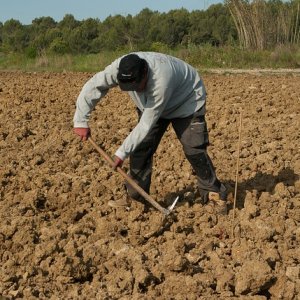Mechanization Can Transform Agriculture But Scaling Is a Challeng

STORY INLINE POST
Agricultural mechanization introduces machines or farm tools that increase labor efficiency, reduce drudgery, and enhance precision in field operations. It is widely seen, therefore, as an engine for agricultural transformation, although options for smallholder farmers are often limited. Mechanization alternatives are even scarcer for women farmers who are frequently left in charge of rural households when male family members migrate to urban centers in search of more remunerative employment options, and youth is discouraged from working in agriculture due to the associated intensive physical labor demands and low-income opportunities.
To help redress these trends and achieve a positive and long-lasting impact, agricultural mechanization must go beyond introducing large-scale, cutting-edge equipment to the field in an attempt to boost the productivity of small- and medium-sized farming systems. Instead, a systems approach is necessary to improve mechanization of smallholder agriculture and determine if machinery may be scaled to its full potential. In other words, the challenge is not to develop new machinery or tools to transform food systems but to develop conducive market environments for scaling mechanization in farming communities.
CIMMYT, an international, nonprofit agricultural research organization based in Mexico, has systematically analyzed the main obstacles to large-scale adoption of farm mechanization in support of rural development initiatives in low- and middle-income countries. The evidence from mechanization projects implemented in countries like Mexico, Zimbabwe and Bangladesh shows that lack of finance to set up mechanization service provider models and insufficient collaboration between value chain actors to foster and strengthen mechanization entrepreneurs are limiting factors that hamper scaling efforts. Addressing these issues goes beyond the field of agricultural mechanization and requires careful analysis of local markets, and of socio-economic and technical capacities across agricultural value chains.
It is also important to consider that mechanization replaces long-standing traditional, or dominant, practices that are ingrained in farming communities and are often difficult to change. For that reason, it is crucial to understand what practices will be scaled down to create space for the new machinery or equipment that will be introduced in a specific context. Ultimately, mechanization can become a sector that helps attract youth back to agriculture by offering remunerative jobs in rural communities.
CIMMYT takes this view to actively engage in partnerships with international aid agencies and governments across Latin America, Africa and Asia. Some of these ventures include MasAgro in Mexico, where CIMMYT has developed over 40 scale-appropriate machine prototypes for use throughout the production cycle, from land preparation to postharvest in the country’s diverse farming environments.
Narrowing Down Obstacles
CIMMYT uses a Scaling Scan to better understand the enabling environment required for enhancing mechanization efforts. The scan is an easy-to-use and accessible tool that collects quick and structured feedback from local stakeholders about 10 issues, or “ingredients,” that matter when scaling mechanization: Technology/practice, Awareness & demand, Business cases, Value chain, Finance, Knowledge & skills, Collaboration, Evidence & learning, and Public sector governance.
The results show that the Technology/practice and Knowledge & skills indicators generally score very high points, suggesting that most scaling efforts focus on fine-tuning the innovation and on training end-users, while insufficient attention is paid to ingredients of a conducive market environment for scaling, such as Finance, Value chain and Business cases. For that reason, a successful mechanization project must have a systems- and evidence-based scaling strategy to develop, or enable, financing mechanisms along with functioning value chains and business models for a range of actors, including farmers, manufacturers and service providers.
From the start, practitioners and researchers should consider that the best performing technology in the field is not always the most scalable. The Scaling Scan is an effective tool that can guide users to systemically assess the critical ingredients of an enabling environment for scaling that effectively identifies bottlenecks and helps build the consensus needed for meaningful action.
CIMMYT will continue strengthening design sprints, enhancing builder and operator training supported by advanced digital tools, broadening the network of mechanization service providers, and offering modern farm machinery solutions to smallholder farmers across the global south. Awareness and linkages between stakeholders must improve, while technical support, training and access to financial services are required at all levels. Government policies should facilitate local manufacturing with an emphasis on quality and cost effectiveness, including updating and upgrading private sector manufacturing enterprises. With this collaborative and transdisciplinary approach, CIMMYT aims to catalyze agricultural transformation by leveraging yield-enhancing practices, entrepreneurship skills, and sustainable mechanization for more inclusive and sustainable agricultural systems that benefit farmers and communities globally.
Bram Govaerts is CIMMYT’s director general. He is an international authority in maize, wheat and associated cropping systems who works for a successful transition to sustainable intensification of small-scale farming in Africa, Asia and Latin America. Govaerts advises public, private and social organizations worldwide and is an active member of research groups and associations including the A. D. White Professor-at-Large program of Cornell University.








 By Bram Govaerts | General Director -
Wed, 02/14/2024 - 10:00
By Bram Govaerts | General Director -
Wed, 02/14/2024 - 10:00















